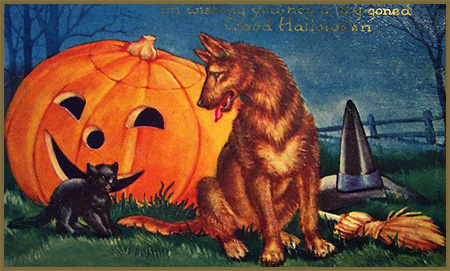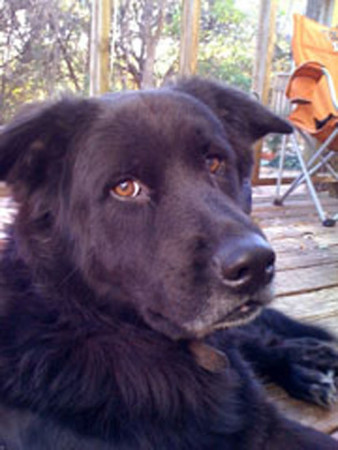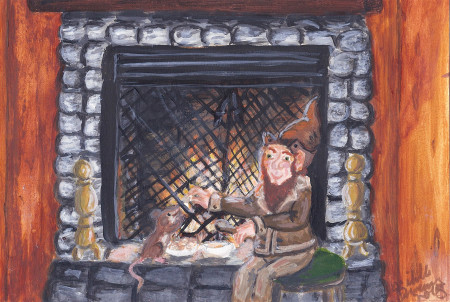
The Hounds of Hell and the Big Black Dogs
-By Angelique Duncan
Like black cats, big black dogs are surrounded by superstition and mystery and associated with a dark place in mythology. These legends can be found in the writings of many ancient cultures going as far back as the Greeks, Celts and Norse mythologies pre Christianity and persist into modern culture on nearly every continent. Although they have been given many different names; Phantom Dogs, Devil Dogs, Fairy Hounds, and Fire Hounds, most commonly they are known as Hellhounds.
The descriptions vary from culture and continent, however there are commonalities that tie the legends to the same sort of canine beast. They are unnaturally big and black. Often described as having razor sharp teeth, large feet with claws and glowing eyes of red or yellow. Their fur is said to be long, wild and unruly. Hellhounds are believed to have a loud, ferocious and frightening growl, emit a foul odor of death or smoke and breathe fire. They are said to have supernatural speed and strength and in some legends leave a trail of fire left where they have ran or burning embers where they have sat. Some say they have a ghostly specter appearance. In some regions they appear as a normal dog of unusual size but can shape shift or disappear at will. In some mythologies they are said to be three headed and in others headless.
Depending on the culture the belief in their purpose in this world varies. To some they are an omen of something bad to happen. To others they are sacred guardians. Many believed that they guard the gates to Hattie or the openings to the underworld of death. Known by some as the Bearers of Death, myths say that Hellhounds are sent by demons to retrieve souls that belong in hell or owe a debt to the devil. Others say they collect the undead who wander the earth aimless and take them to the world of the deceased. The Welsh, as well as other cultures, believed that they may only hunt for souls at designated times of year such as during the Wild Hunt. It is widely thought in Europe that the hounds may enter this world on the night of the Autumn Equinox and remain until the end of Winter at the Spring Equinox. Some believe they appear on Halloween and may roam freely to hunt until the night of the Winter Solstice. Some say they are allowed to enter this world such days as Good Friday, All Saints Day or Christmas Eve.
Superstition has it that if one looks into the eyes or hears the bark of a Hellhound it is an omen that great tragedy will come or that the individual or some one they love will die. Some legends say one must sight a hellhound three times to be taken by it.
Magical Fairy Hounds are thought to be protectors of the supernatural world. They guard the faeries and elves that pass through to the mortal world. Some say that they guard the treasure and sacred mystical grounds of the magic folk. They can be seen as a large dog wandering the woods, however if one gets too close to what they are guarding they will turn into a viscous attack creature.
Early Christians would bury a black dog alive on the grounds of a freshly built church believing the spirit of the dog would protect the building, grounds and congregation. In some European, Germanic and Nordic cultures it is believed the hellhounds are the returned spirits of dogs who where killed by this practice wandering the earth either to exact revenge for their ill fate or because their souls are now trapped and cannot go on to the afterlife.
In some legends the hellhounds are believed not to be evil, but benevolent in nature. It is said they can be summoned to protect a people. Once called upon they are fiercely loyal and will imprint on that individual their entire life. They are sometimes sent to watch over a good soul who is ill to prevent demons or the devil from stealing them to hell and ensure the soul has safe passage to heaven undisturbed. Another folklore tells that the hounds are sent as messengers to deliver the communication that a loved one has passed. Mysterious large dogs seen in graveyards are said to be protecting the resting place of their loved ones or have been summoned to protect a special grave.
Till this day, people all over the globe claim sightings of Hellhounds documented through photographs, videos and written testaments. They have claimed to be seen in forest, churches and graveyards and upon deserted roads. Whether these sightings are supernatural spirit dogs or wild lost dogs wandering without a home is not confirmed.
Not unlike the superstitions surrounding black cats, black dogs have suffered the discriminatory consequences of these legends and folklores. Today big black dogs are the least adopted of all dogs in shelters and are euthanized at greater rates than other colors of dogs. Surveys by shelters and animal rights groups show that people still connote black dogs with Hellhounds and some kind of evil. People will show fear when approached by a big black dog whereas they will not fear a yellow, white or brownish dog. The reality is big black dogs are wonderful, loyal and make great companions. If you are looking to add a canine to your family, consider adopting a big black dog. They may just be the greatest friend and guardian you will ever encounter.

In loving memory of Doss; loyal friend, fierce protector and beautiful soul.
*This article has not been written to perpetuate the fears of black dogs. Quite the opposite, it has been written to examine the history of why people fear black dogs and encourage folks to see them for what they are; majestic beautiful animals who need to be loved too and encourage folks to adopt big black dogs.
To learn about Black Dog Syndrome and adoption visit Petfinder
Angelique Duncan is proprietor of Twilight Faerie Nostalgic and Capricious Objects. Check out her artist page to find links to her shops and vintage inspired traditional holiday art. Visit again next month for more traditions and folklore.

